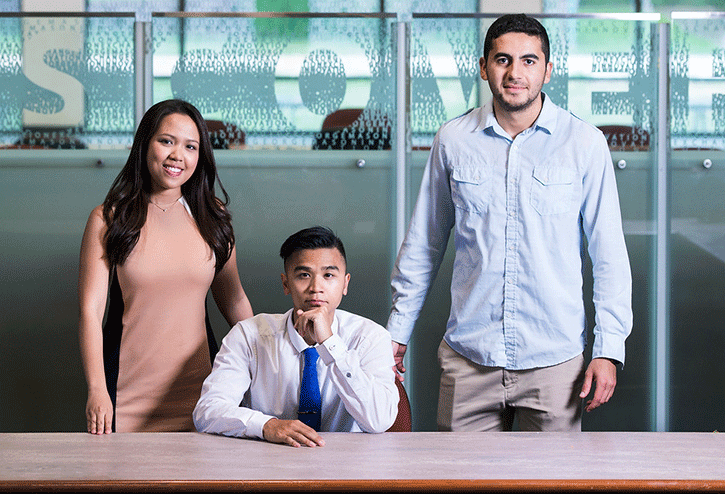Past Senior Design Projects
If you want to see some interesting student projects, you've come the right place. Every Systems Engineering student completes a Capstone Project before graduation. These budding engineers are finding ways to make air traffic systems flow better, manage sediment in the waterways of the East Coast, and detect underwater mines to protect shipping lanes.

Engineering students (right to left) Karar Majeed, Alex Wong, and Pwint Htwe created the robot assistant as their senior capstone design project. Photo by Evan Cantwell/Creative Services/George Mason University
“Our professors always tell us – use engineering to make the world a better place,” explains systems engineering major Hanan Al Jarash, “so when I learned about a robot assistant, I knew I just had to do it.”
Al Jarash’s teammate, Pwint Htwe said, “The country’s population is aging because of demographics and improved health care. There is also a national nursing shortage, so we figured a robot assistant for older adults might bridge a gap between what people need and what they have.”
The team started with a detailed context analysis and a stakeholder analysis. The context analysis establishes the market size and, more important, exactly what the need is. The stakeholder analysis identifies all the people and entities that are involved in the process and whether they seek to change the system or maintain status quo.
“After an exhaustive requirements gathering process we established that the best way to fill the patient-nursing shortage gap was to serve patients with mobility impairments,” said Alex Wong
The students learned that homebound mobility impaired patients could be supported by a robotic assistant that could relieve nursing duties on the order of 2-3 hours a day. The patients needed three tasks to be performed:
Fetch or move household objects such as a book, reading glasses, or a sealed bottle of water.
Perform a visual inspection in a remote part of the house. For example look out the window to see why the dog is barking.
Provide voice communication with someone in a remote part of the house. For example, opening the front door and greeting a guest.
“Once we had the requirements for the product including weight, reliability, security, we launched into the design phase. We had to experiment with many different components. Sometimes the only way to find out is to try it. We did a lot of trail-and-error testing,” said Karar Majeed.
Slowly, one step at a time, the robot took shape.
“We learned how challenging engineering can be,” said Wong. “On paper and in simulation the design looked perfect. But when we put the pieces together the weight of the battery changed the contour of a structural member that now rubbed against one of the wheels. Also the power control system could not provide the right power to the motors and to the Raspberry/Pi controller.”
The project culminated with a demonstration at the System Engineering & Operations Research Department Advisory Board’s annual meeting. The prototype robot delivered a water bottle to a very surprised department chair, Ariela Sofer.
“We are proud of our students and the Systems Engineering program here at George Mason University,” said Sofer. “Using their engineering skills and knowledge, these students really are making the world a better place.”
The students graduate soon, and are seeking venture capital and/or a teaming arrangement to move their prototype to a commercial product. Perhaps sometime in the not-to-distant future, families will be able to surprise a loved one with the gift of a robotic assistant that was conceived, designed, and tested right here at Mason.
